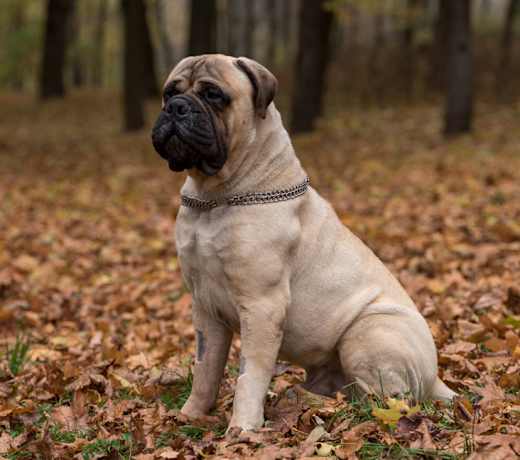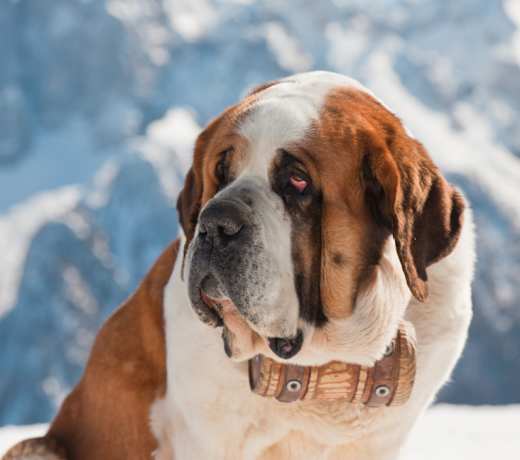The rarest color for a Neapolitan Mastiff is solid chocolate, a deep and rich brown hue. While blue, black, brindle, and tawny are more common, the chocolate color is less frequently seen and is often highly prized by enthusiasts of the breed. This rich, distinctive color adds an extra layer of uniqueness to an already impressive dog, making dogs with this coat color particularly sought after by those looking for something a bit different in a Neapolitan Mastiff.
Neapolitan Mastiff
Breed Type: Working
Common nicknames: Neo, Mastino
Coat: Smooth
Hypoallergenic: No, they will likely trigger allergies.
Temperament: Loyal, protective, affectionate, calm
Life expectancy: 7-9 years
Color & patterns: Blue
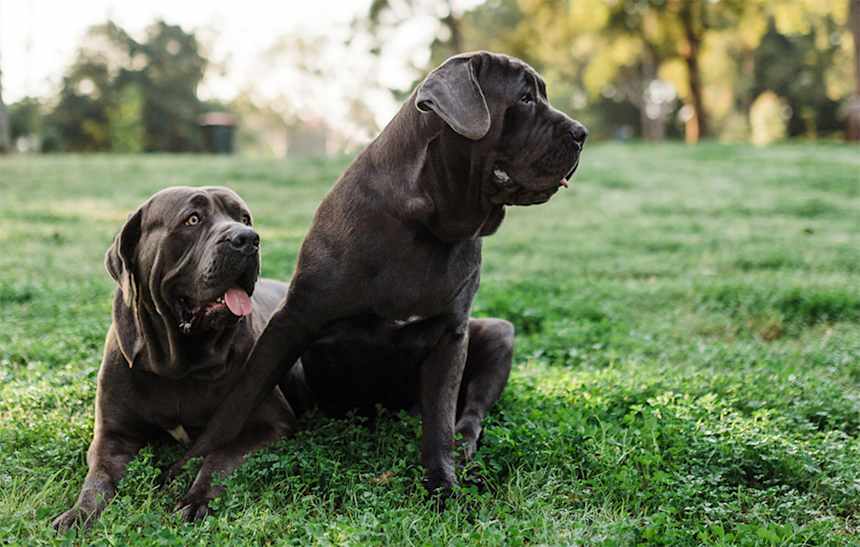
The Neapolitan Mastiff commands attention with their signature wrinkles, droopy skin (which sets them apart from other mastiffs), and powerful build. Despite their imposing stature, the Neapolitan Mastiff can be quite affectionate and is known to be good with children when properly socialized; this breed has a calm and gentle demeanor and often forms strong bonds with their loved ones. They have protective instincts and make excellent guard dogs and loyal family companions. If you’re seeking a devoted and protective pup who will shower you with love, the Neapolitan Mastiff could be the breed for you.
Neapolitan Mastiff characteristics
Learn about about Neapolitan Mastiff basics like their fur colors, shedding levels, how much grooming they need, and other Neapolitan Mastiff facts.
Average height
24-31 inches (61.0-78.7cm)
Average weight
90-153 pounds (40.8-69.4 kg)
Average lifespan
7-9 years
Exercise needs
Grooming needs
Full-grown size
Good with cats
Good with kids
Training aptitude
What colors do Neapolitan Mastiffs come in?
Neapolitan Mastiffs come in a variety of rich, solid colors. The most common colors are blue (a dark, slate-gray shade) and black. You’ll also find them in mahogany, which is a deep reddish-brown, and tawny, a light, warm fawn color. Some Neapolitan Mastiffs have brindling, which means they have stripes or streaks of a different color over their base coat.
How big is a full grown Neapolitan Mastiff?
A full-grown Neapolitan Mastiff is an impressive sight. These dogs are large and powerful, with males typically weighing around 150 pounds and standing about 26 to 31 inches tall at the shoulder. Females are slightly smaller, weighing around 110 pounds and standing 24 to 29 inches tall. They typically reach their full height by 12 to 16 months of age and will continue to fill out and gain muscle mass until they’re about three years old.
Several factors can influence a Neapolitan Mastiff’s final size. Genetics play a big role, with the size of the parents being a good indicator of how large a pup might grow. Nutrition is also crucial, as a balanced diet supports healthy growth. Overfeeding, especially during the puppy stage, can lead to overly rapid growth, putting stress on their developing joints. Exercise and overall health also contribute to their final size, with proper care ensuring they reach their full potential without any growth-related issues.
Do Neapolitan Mastiffs shed?
Yes, Neapolitan Mastiffs do shed, but they’re not heavy shedders compared to some other breeds. They have a short, dense coat that sheds moderately throughout the year, with a bit more shedding during seasonal changes in spring and fall.
Brushing once or twice a week can help manage the shedding by removing loose hairs and keeping their coat healthy. Even though they shed, their short coat makes grooming relatively easy, so it’s not too much of a hassle to keep their shedding under control.
Are Neapolitan Mastiffs good with other dogs?
Yes, some Neapolitan Mastiffs can be good with other dogs, but early socialization around a range of pups is often crucial. Since they are a protective and sometimes territorial breed, it’s really important to help them feel comfortable around other pups both at their home and in neutral, public environments.
If you’re considering adopting a Neapolitan Mastiff with an unknown history around other dogs, it’s best to do some meet-n-greets with them and a few other pups to assess their compatibility with other dogs prior to the adoption.
Neapolitan Mastiff temperament
Learn about about the Neapolitan Mastiff temperament and how well they fit into your lifestyle, home environment, and family.
Are Neapolitan Mastiffs good with kids?
Yes, Neapolitan Mastiffs can be good with kids, thanks to their protective and affectionate nature. These dogs were bred to be loyal and gentle with their family members, including children. They tend to be very patient and tolerant, which makes them good companions for kids, especially if the pup has been well-socialized from a young age.
However, because of their large size and strength, it’s important for pet parents and parents of children to supervise interactions between a Neapolitan Mastiff and young children to ensure everyone’s safety. Even the most well-behaved Mastiff might accidentally knock over a small child simply due to their size. Teaching both the dog and the kids how to interact with each other respectfully and safely is key.
Are Neapolitan Mastiffs good with cats?
Yes, many Neapolitan Mastiffs are good with cats, but it largely depends on their individual temperament and how well they’ve been socialized. These dogs have strong protective instincts and can be territorial, so early socialization is key. If a Neapolitan Mastiff is raised around cats and taught to see them as part of the family, they can coexist peacefully.
However, because of their size and strength, it’s important to monitor their interactions, especially in the beginning. Even a well-meaning Mastiff might be a bit too rough for a cat, so supervision is crucial until you’re confident they’re comfortable together.
If you’re introducing a Neapolitan Mastiff to a cat for the first time, take it slow. Using scent introductions and gradual exposure can help them adjust to each other. With patience and proper introductions, many Neapolitan Mastiffs can live harmoniously with cats.
Do Neapolitan Mastiffs bark much?
No, most Neapolitan Mastiffs do not bark much. They tend to be more on the quiet side, primarily barking when they sense a threat or feel the need to protect their family. Their natural guarding instincts make them alert and watchful, so when a well-socialized Neapolitan Mastiff does alarm bark, it’s usually for a good reason.
That said, like any dog, they can develop barking habits if they’re bored, anxious, or lack access to consistent companionship, exercise, enrichment, and restorative sleep.
Are Neapolitan Mastiffs good family dogs?
Yes, Neapolitan Mastiffs can make good family dogs for the right household. They tend to be incredibly loyal, protective, and affectionate with their family members. Known for their strong bonds with their loved ones, these dogs are often gentle giants with those they trust.
Their natural guarding instincts mean they are often watchful over their family and house. They thrive in a calm, stable environment where they can be part of the family’s daily life.
While they are usually calm and laid-back, Neapolitan Mastiffs do need consistent training and socialization to ensure they are well-behaved and comfortable around other people and animals as they can be wary of strangers. Early socialization is crucial to help this breed feel secure and at-ease in a range of environments.
For families who are experienced with large breeds and have the space to accommodate a big dog, a Neapolitan Mastiff can be a loving and devoted companion.
Are Neapolitan Mastiffs easy to train?
Yes, Neapolitan Mastiffs can be easy to train with positive reinforcement and relationship-based methods. Neapolitan Mastiffs have an independent nature, which means they may not be the easiest dogs to train, but they’re definitely trainable with the right approach. Their independence comes from their strong guarding instincts, so they like to think for themselves and might not always be eager to follow cues just for the sake of it.
These dogs respond best to positive reinforcement and relationship-based training, where the focus is on building trust and mutual engagement between the dog and their pet parent. Training sessions should be kept short and engaging, making sure to keep things fun and rewarding. Rewarding them with treats, toys, and affection goes a long way in motivating them to learn. Consistency and patience are key, as Neapolitan Mastiffs need to feel that they’re working with you rather than being forced to do something.
Just keep in mind that even if a certain dog breed is known to be easy to train, training any dog requires a long-term commitment.
Do Neapolitan Mastiffs like to cuddle?
Yes, Neapolitan Mastiffs often like to cuddle with their family. They may have a tough exterior, but these big pups are often quite affectionate with those they trust and tend to enjoy cuddling with their family. Despite their size and intimidating appearance, they’re often quite content to snuggle up with you, whether it’s on the couch or at your feet.
Their strong bond with their family means they seek out physical closeness as a way of showing affection and feeling secure. So, if you’re looking for a big, cuddly companion, a Neapolitan Mastiff can definitely fit the bill. Just be prepared for a lot of dog when they decide they want to cuddle!
Why are Neapolitan Mastiffs so droopy?
Neapolitan Mastiffs are known for their droopy appearance, which is primarily due to their loose, wrinkled skin. This unique feature has been bred into the breed over centuries to serve a practical purpose. The droopy skin, especially around their face, neck, and chest, was originally developed to protect them during fights or while guarding. If an intruder or another animal tried to grab them, the loose skin would allow the Mastiff to twist and turn more easily, reducing the chance of serious injury.
Can Neapolitan Mastiffs be left alone?
Yes, Neapolitan Mastiffs can be left alone for a few hours per day, but they prefer being around their family. If left alone for too long, especially on a regular basis, they might experience separation anxiety, which can lead to chronic stress and destructive behavior.
Because of their size and strength, it’s important to ensure they’re comfortable and mentally stimulated if they need to be left alone. Providing them with toys, puzzles, and a safe space can help keep them occupied. Gradual training to help them get used to being alone is also beneficial, starting with short periods (sometimes a minute or less at first if they have separation anxiety) and gradually increasing the time as they become more comfortable with absences.
Ideally, Neapolitan Mastiffs do best in homes where they can have regular companionship. If you need to leave them alone for longer stretches, it’s a good idea to arrange for someone to check in on them or consider doggy daycare. These measures can help ensure they stay happy and well-adjusted, even when you’re not around.
Are Neapolitan Mastiffs intelligent?
Yes, Neapolitan Mastiffs are intelligent dogs and especially shine in their ability to think independently and assess dynamic environments. This is due to centuries of breeding that selected for a dog who could independently protect farms and families.
While they might not be as quick to learn complex tricks as some other breeds, their intelligence shines in areas that align with their natural instincts.
Their intelligence, combined with their loyalty and protective nature, makes Neapolitan Mastiffs incredibly capable dogs.
Neapolitan Mastiff history
Learn about where the Neapolitan Mastiff came from.
Where are Neapolitan Mastiffs from?
Neapolitan Mastiffs, also known as Mastinos, are from Italy, specifically around Naples — hence their name. These massive, wrinkled dogs have ancient roots, likely resulting from cross-breeding short-haired Indian dogs with Macedonian and Epirian war dogs and large Neapolitan farm dogs.
They’ve been around for centuries and were developed to have an intimidating appearance designed to scare off intruders while still being affectionate and loving to their families.
Neapolitan Mastiff health
Learn about about the Neapolitan Mastiff health outlook and what diseases they may be prone to at various stages of their life.
Do Neapolitan Mastiffs have a lot of health problems?
Yes, unfortunately, Neapolitan Mastiffs can suffer from a lot of health problems, especially if they aren’t carefully bred to have a stable body structure.
Additionally, like many giant breeds, Neapolitan Mastiffs have a fairly short lifespan. On average, you can expect these big pups to live seven to nine years. This lifespan, while much shorter than smaller-sized dogs, is on par with other Mastiff breeds.
What diseases are Neapolitan Mastiffs prone to?
Neapolitan Mastiffs are prone to a variety of health conditions. Here are some common issues they may face:
Hip and elbow dysplasia: These are developmental conditions where the hip or elbow joints don’t fit properly into their sockets, which can lead to arthritis and pain. Veterinary check-ups, physical therapy, pain medication, and maintaining a healthy weight can help manage these conditions.
Eye problems: Neapolitan Mastiffs are susceptible to several eye issues, including cherry eye, which is when the gland of the third eyelid protrudes and becomes visible; entropion, a condition that causes the eyelids to roll inward, irritating the cornea; and ectropion, which causes the eyelids to roll outward, which can lead to dryness and irritation.
Progressive retinal atrophy (PRA): A genetic condition that leads to degeneration of the retina, causing vision loss.
Dilated cardiomyopathy: This is a condition where the heart becomes enlarged and weakened, affecting its ability to pump blood efficiently. Regular heart health monitoring is crucial.
Autoimmune thyroiditis: An autoimmune condition where the body attacks the thyroid gland, leading to hypothyroidism and potentially affecting overall health.
Gastric torsion (bloat): A serious condition where the stomach twists and fills with gas, which can be life-threatening and requires immediate veterinary attention.
Degenerative disc disease: This condition affects the spinal discs, leading to pain and mobility issues. Keeping them at a healthy weight and providing appropriate exercise can help manage this.
Osteosarcoma: A type of bone cancer that can affect large breeds. Routine veterinary check-ups and being attentive to any signs of lameness or swelling are important for early detection.
Given their size and breed characteristics, Neapolitan Mastiffs benefit from routine health screenings and proactive care to manage these potential issues. Annual vet check-ups, a balanced diet, and proper exercise can help maintain their health and well-being.
Are Neapolitan Mastiffs high maintenance?
No, Neapolitan Mastiffs aren’t high-maintenance in terms of their grooming needs, but they do require weekly care to maintain their skin and coat health.
Grooming a Neapolitan Mastiff involves several important tasks to maintain their health and comfort. Their loose, wrinkled skin requires special care. You should routinely clean the deep folds and wrinkles with a damp cloth or pet-safe wipe, ensuring you dry them thoroughly to prevent moisture buildup, which can lead to skin infections or irritation.
Brushing their short coat once or twice a week helps manage shedding and keeps the coat healthy. Consistent nail trimming is also crucial; keeping their nails short supports proper stance and prevents joint issues. Typically, trimming every two to four weeks is necessary.
Ear care involves checking their ears for infection or buildup and cleaning them every few weeks with a pet-safe ear cleaner. Bathing should be done about once per month or so to manage odors and keep their coats clean, using a mild, pet-safe shampoo.
Are Neapolitan Mastiffs hypoallergenic?
No, Neapolitan Mastiffs are not hypoallergenic. Their short, dense coat and the significant amount of loose, wrinkled skin can contribute to shedding and the production of dander, which may trigger allergies in sensitive individuals.
For those with allergies, it’s important to consider that no dog breed is completely hypoallergenic, but some breeds may produce fewer allergens than others. If you’re sensitive to dog allergens, it’s important to spend time with the dog to assess how you may react before committing to adoption.
Additionally, to reduce dog allergens in your home, clean regularly by vacuuming with a HEPA filter and mopping floors. Use air purifiers. Wash your hands and change clothes after interacting with your pet, and designate pet-free zones in your home, especially in bedrooms.
Popular Neapolitan Mastiff mixes
Neapolitan Mastiffs have been mixed with various breeds, creating some interesting and unique mixed-breed pups. Here’s a look at some of these mixes:
Nekita (Neapolitan Mastiff + Akita)
Neahond (Neapolitan Mastiff + Keeshond)
Ultimate Mastiff (Neapolitan Mastiff + Dogue de Bordeaux)
American Neo Bull (Neapolitan Mastiff + American Bulldog)
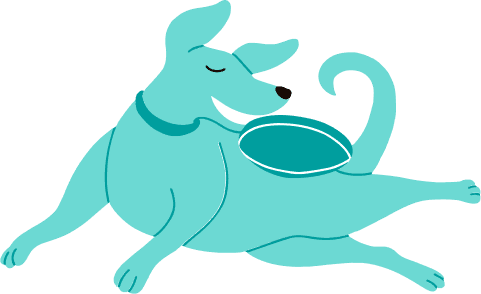
Find Neapolitan Mastiff puppies near you
Adopting a Neapolitan Mastiff
Learn about acquiring a Neapolitan Mastiff - the pros and cons of adopting versus going through a breeder, and associated costs.
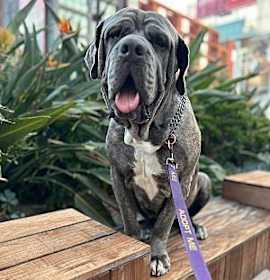
Zen
Neapolitan Mastiff Mastiff
Male, 5 yrs 3 mos
Beverly Hills, CA
Good with dogs
Not good with cats
Needs experienced adopter
House-trained
Spayed or Neutered
Shots are up-to-date

DALTON
Neapolitan Mastiff
Male, 3 yrs 3 mos
Chatsworth, CA

Zen
Neapolitan Mastiff Mastiff
Male, 5 yrs 3 mos
Beverly Hills, CA
Good with dogs
Not good with cats
Needs experienced adopter
House-trained
Spayed or Neutered
Shots are up-to-date

DALTON
Neapolitan Mastiff
Male, 3 yrs 3 mos
Chatsworth, CA

